Top Story: Environment
Progress is in the bag at the beach
November 20, 2014
A wedding gown, a polar bear suit, even a fake human skull — volunteers have turned up all sorts of discarded items on Coastal Cleanup Day in Los Angeles County.
This year, along with the usual cigarette butts and crumpled cans, they found a gun near the Malibu Pier and a piece of a firearm under the Redondo Beach Pier, triggering police investigations.
And, of course, they also found another kind of scary item that always seems to turn up amidst the heaps of sodden shoreline garbage: the single-use plastic bag, which is among the 10 types of litter most frequently collected in the ocean, lakes, rivers, creeks and storm drains.
But these days, the tide may be turning against the bag.
“We’ve seen a significant reduction in plastic bags as a component of what’s collected,” says Department of Public Works recycling and waste reduction program manager Coby Skye.
He said that data compiled by the environmental organization Heal the Bay, which analyzes samples of the trash its members and volunteers haul out of coastal and inland waterways, tells the story. In 2010, an estimated 5,000 plastic bags were collected. In 2011 and 2012, that number dropped to about 3,000. And by last year, the count was down to some 2,000.
“It stands to reason there’s going to be less waste because we know fewer plastic bags are being distributed,” said Heal the Bay spokesman Matthew King.
The rapid decline of littered, single-use bags, according to King and others, is a direct result of bans enacted throughout the region in recent years, including one approved in Los Angeles County by the Board of Supervisors in November, 2010. That one is now widely credited with setting the stage for California to recently become the first state in the nation to restrict single-use plastic bags.
In California, almost 20 billion plastic bags are used each year, many of which end up as litter, creating urban blight and flooding hazards. Animals can get tangled up in them, or mistake them for food and starve to death.
Since discarded plastic bags are non-biodegradable, they could harm wildlife and the environment for hundreds of years, and possibly as long as a millennium. Supervisor Zev Yaroslavsky, after voting to approve the ban, called them “urban tumbleweeds.”
San Francisco passed the first ban in the state 2007. Soon following suit were Malibu, Manhattan Beach, Fairfax and Palo Alto. But there, the momentum stopped, when other municipalities were scared off by lawsuits pushed by the plastic bag industry, which accused cities with bans of failing to prepare required environmental impact reports.
The county rendered that argument moot in November 2010 by passing an ordinance with an accompanying environmental impact report that focused on all cities within its boundaries, not just unincorporated areas.
“Soon after, jurisdiction after jurisdiction adopted bans,” Skye said, adding some of them copied the county’s ordinance verbatim and many of them relied on its environmental impact report.
“I think the fact that the county did it on a large scale made other regions more comfortable,” King said.
The city of Los Angeles became the largest city in the nation to ban plastic bags when it adopted an ordinance in June, 2013, that relied on data in the county’s environmental impact report.
The state, in its recent ban, also relied on the county’s ordinance.
Authored by state Senator Alex Padilla (D-Pacoima), SB 270 bans groceries and pharmacies from distributing plastic bags after July 2015. Convenience and liquor stores must comply a year later.
The state law would also provide up to $2 million in loans to businesses transitioning to manufacture reusable bags.
The plastic bag industry, however, is petitioning to repeal SB 270, arguing that 30,000 jobs are at stake and that unwashed reusable bags can breed dangerous bacteria.
In a statement posted on the American Progressive Bag Alliance website, Plastics Industry Trade Association President William Carteaux said: “The truth is singling out one product that makes only less than one percent of the U.S. municipal solid waste stream will have no meaningful impact on reducing litter,” he added. “Instead, it will result in forcing consumers to use products such as reusable bags, which are mostly imported from China, made from foreign oil and are not recyclable.”
If the Alliance can gather half a million signatures over a 90-day period to qualify a referendum, then the statewide plastic bag ban would be suspended pending the results of the November 2016 ballot.
King believes voters should uphold the ban.
“People often wonder, ‘Don’t we have bigger issues to worry about than plastic bags?’ ” he said. “Certainly, the state and the world are grappling with a lot of major issues but I do think plastic bags are important.”
“I like to call them a gateway issue because it gets people thinking about the impact of their other habits on the environment,” he added. “After a conversation about plastic bags, you might also start wondering, for example, whether to use single-use plastic water bottles to your kids’ soccer game or just bring a big thermos. It’s very positive to have this process, this debate.”
Posted 11/20/14
Up a tree and loving it
October 16, 2014
Michell Sanchez was only a teenager at the time, but she came of age as an environmentalist when TreePeople first walked onto her high school campus more than a decade ago.
Sanchez was an early—and enthusiastic—participant in Generation Earth, a hands-on environmental education program sponsored by the Los Angeles County Department of Public Works and carried out by TreePeople in local middle schools and high schools since 1998. Funding for the next two years, with renewals possible for 4½ years after that, was approved this week by the Board of Supervisors. The investment—which could total $4.35 million over the life of the current contract—promises results that go well beyond the classroom.
Just ask Sanchez.
Not only did the program inspire her to help lead a team of Grant High School students to launch an on-campus recycling program—and later to create a native plants butterfly garden that still flourishes at the school—but it also influenced what she went on to study in college. (She received her degree in environmental science and policy from Cal State Long Beach.)
Now 25, Sanchez works for TreePeople as a development associate and doesn’t hesitate to sing the praises of the program that got her started.
Generation Earth, she says, left her feeling “empowered and inspired.”
“It really helped guide me to what I wanted to do,” Sanchez says.
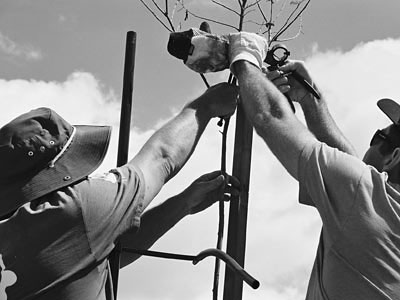
Students strenghten a just-planted tree as part of the Generation Earth program, which has been going strong since 1998.
Sanchez is among the hundreds of thousands of high school and middle school students who have taken part in Generation Earth since the program started. In just the past seven fiscal years, 228,188 students created 2,697 projects at 244 schools.
While Sanchez worked on recycling and gardening, other student endeavors over the years have ranged from e-waste collection events to an urban runoff audit whose results were publicized via social media.
“It’s basically to inspire the students to take personal responsibility about the environment, and then transforming that into action by doing a service-learning project on campus,” says Edna Gandarilla, who manages the program for Public Works.
Some of those actions can have an enduring impact. Diamond Bar students, for example, convinced school district officials to install water-efficient sprinklers at their high school. “They noticed that when the sprinklers were on, they were watering the sidewalks and they were just wasting a lot of water,” Gandarilla says.
Candice Russell, TreePeople’s director of environmental education, says her group’s partnership with Public Works represents a “wonderful symbiosis” that is unparalleled anywhere else in the state.
“This is a very unique program,” Russell says. “It’s a beautiful marriage between TreePeople’s mission—to inspire the people of Los Angeles to take personal responsibility for the urban forest—and the county’s goal of educating the students of Los Angeles.”
It’s also a good barometer of which environmental issues seem most pressing to the younger generation.
“People are fascinated by water, especially because of the drought. It’s huge,” Russell says. “In addition to that, school greening. They want green campuses. They want healthy, viable, green campuses and they want to have a part in making it.”
Waste issues and stormwater solutions also get lots of attention, in part because of two popular contests that pit schools against each other in friendly competition each year. “Battle of the Schools” is a pounds-of-recycling-per-student smackdown, while “Streets to the Sea” showcases student media messaging campaigns about stormwater.
Secondary school students aren’t the only ones getting some environmental consciousness-raising. A second DPW-sponsored program, called Environmental Defenders, stages elementary school assemblies starring actors who play characters extolling the virtues of the Four Rs. (Those would be Rethink, Reuse, Reduce and Recycle.)
As a practical matter, such educational efforts help the county keep up with state mandates to reduce the amount of trash going into landfills, while also spreading a multi-faceted environmental message to a large and growing audience.
Because it turns out that what happens at school doesn’t stay at school.
Students are “great influencers of their parents,” said Public Works spokesman Kerjon Lee. “We’ll have kids going home and telling their parents not to take longer than 5-minute showers. They’re great messengers for us.
“At that age, we know they’re still open to adjusting their own behaviors. And they also feel really good about having an impact. Basically, we’re training young people on how to be better citizens, not just better environmental stewards.”
Posted 10/16/14
Trouble at sea
September 18, 2014
A punishing heat wave sent thousands of people fleeing to the beach this week, but many who tried to cool off in the ocean found themselves in hot water instead.
The Los Angeles County Fire Department’s Lifeguard Division saved more than 1,000 swimmers and surfers swept up by rip currents and other hazards over a five-day period when temperatures peaked at 107 degrees in the San Fernando Valley.
This brought the lifeguards’ total number of rescues up to about 12,000 since January. That’s their third highest tally ever in a single year — with three months still remaining in 2014.
Acting Chief Lifeguard Steve Moseley attributes the spike to a rare confluence of factors: A surge in beach attendance driven by extended periods of unseasonably hot weather, more frequent occurrences of high surf and a warmer ocean.
“All of these contributing factors have combined to create one of the busiest years in recent memory for the Lifeguard Division,” Moseley said.
To date, beach attendance has hit 61 million — well past the 20-year average of 54 million and on pace to exceed last year’s 71 million.
“It’s been so hot inland that everybody’s coming to the beach, even on a Tuesday or a Wednesday,” said Ocean Lifeguard Specialist A.J. Lester. “And because ocean temperatures are warmer, everybody’s staying in the water all day long.” (Tips on staying safe on the beach are here.)
Jet Propulsion Laboratory climatologist and oceanographer Bill Patzert said swimmers and surfers have been particularly vulnerable to being swept away by rip currents, and falling into deep grooves on the ocean floor.
He explained several hurricanes and tropical storms spawned by El Nino conditions in the equatorial Pacific scored the ocean floor, leaving uneven contours.
“The county’s south-facing beaches have been hit with big waves, almost week after week,” Patzert said. “Hurricane Norbert is breaking up, but we have yet another one forming now.
“Because these tend to change the configuration of the ocean bottom,” he added, “people very easily can get into water over their heads in these rip currents.”
Lester said the county employs 200 full-time and 700 part-time lifeguards and has “needed every one of them.” He himself rescued 18 people in a single day last spring, including a pair of boogie-boarding teenagers swept away by rip currents.
“The sister was screaming blood-curdling screams because her brother had fallen off his board and, basically, he was drowning,” Lester said. “I wrapped them around my rescue can but a wave slammed us down to the bottom, and when we got back to the surface, we were all spitting up water.”
Moments after he brought the siblings ashore, he had to dive back in for yet another double rescue. “Then I returned to my tower and parked my truck, but before I could even dry off, we had to pull more people out,” Lester said.
“It’s gotten to the point sometimes when we’re going from one rescue to the next,” Lester said. Still, he added, “There’s nothing more rewarding than completing a rescue, coming back to the beach, and watching those kids run back to their parents, and they’re all hugging each other, and thanking us.”
Section Chief Chris Linkletter said lifeguards also have racked up 1 million “preventions.”
“This means we have prevented that number of people from either becoming rescues or getting into a hazardous situation,” she said.
Amid all the rescues, however, there also have been mishaps.
On Monday, a lifeguard driving a pickup truck back to his tower accidentally ran over a sunbather, who survived but sustained fractures and lacerations to her internal organs.
It was the second such accident this year. In May, another sunbather was hit by a county beach maintenance vehicle.
Posted 9/18/14
Mountain protections soon a reality
September 10, 2014
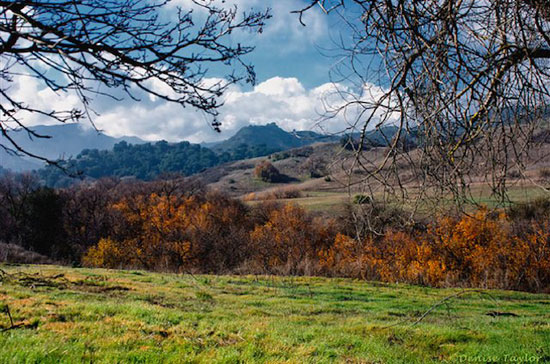
New development rules will keep the Santa Monica Mountains looking like this for future generations.
Culminating one of Los Angeles County’s longest-running environmental efforts, the Board of Supervisors on Tuesday gave final approval to a series of sweeping development restrictions that will preserve the Santa Monica Mountains as one of the nation’s premiere—and pristine—urban recreational treasures.
Passage of the Local Coastal Program (LCP) will protect an 80-square mile swath of environmentally sensitive land from construction that already has scarred some of the mountain region’s most scenic ridgelines and jeopardized fragile wildlife and plant habitats. The plan will preserve the flow of natural streams, outlaw certain rodent poisons and keep the night skies dark through tough outdoor lighting restrictions.
“We only have one Santa Monica Mountain range, and God isn’t making them anymore,” said Supervisor Zev Yaroslavsky, who vowed that the LCP will “protect one of the most beautiful mountain ranges in the state of California. It’s not the High Sierras, but then the High Sierras aren’t the Santa Monica Mountains, either.”
For nearly a decade, Yaroslavsky has championed the plan, alongside the county’s regional planning department and a broad coalition of organizations and individuals with a stake in the mountains.
During a public hearing Tuesday, the only opposition came from a handful of vintners, some of whom own vineyards in the Santa Monica Mountains above the Malibu coastline. They opposed a rule that, under the new plan, would ban the establishment of new vineyards because of their water consumption and the silt that can flow from them into natural streams, endangering wildlife.
Leading the vintners was Don Schmitz, who, in earlier hearings, had lobbied against the LCP’s rigorous new construction restrictions. Schmitz insisted that vineyards are as environmentally friendly as other forms of agriculture permitted under the plan and are a boon to the local economy.
The vineyards, he said, “bring hundreds of thousands of people into the Santa Monica Mountains to go on the wine tours, to go to local wine-tasting rooms, to go to restaurants featuring local wines.”
“It’s important for you to note,” Schmitz told the board, “that this is the Santa Monica Mountains National Recreation Area. It’s not Yosemite, which is a national park. It’s a recreation area.”
Yaroslavsky emphasized that the plan targets only new vineyards, not existing ones like those owned by Schmitz and the others who testified Tuesday. “Nobody is ripping out anybody’s vineyards,” he said.
“Nobody enjoys a glass of cabernet or merlot more than I do,” the supervisor went on to say. “But I have a lot of choices where to get my cabernet. I don’t have a lot of choices where I can see the Santa Monica Mountains National Recreation Area.”
The board approved the LCP by a 3-1 vote. Supervisor Michael D. Antonovich was the lone dissenter, arguing that the vineyard rules unfairly restrict property rights. Supervisor Mark Ridley-Thomas was absent for the vote.
The plan now faces only a final sign-off by the Coastal Coastal Commission, which gave it unanimous approvals in April and July after requesting several minor modifications. The restrictions are expected to go into effect this fall.
Posted 8/27/14
Taking a greener course in Malibu
August 21, 2014
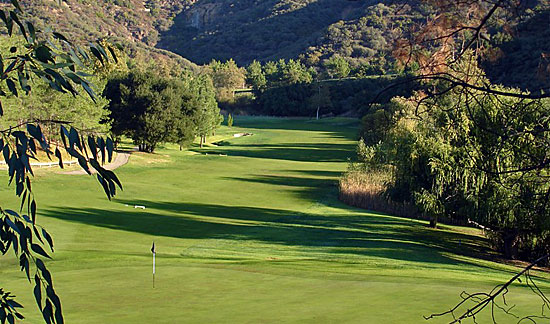
The environmentally-friendly makeover of the Malibu golf course will include a new conference facility.
After eight years of start-and-stop planning and negotiations, the Board of Supervisors this week teed up some good news for golfers in Malibu.
A major—and environmentally state-of-the-art—renovation was unanimously approved on Tuesday for the Malibu Golf Club, a public 18-hole course in the Santa Monica Mountains that has been among the area’s local secrets for generations.
Backed by a group of Silicon Valley-based investors and tucked into a canyon just off of Encinal Canyon Road, the project would modernize the now-fraying and nearly 40-year-old course, maintaining it for the public, and adding a retreat and conference center.
Some 450 acres of native habitat on the 650-acre site would be donated as open space to the National Park Service, and local ponds and creeks would be cleansed of invasive species as part of the project.
The golf course, meanwhile, would be redesigned to save water and make room for new LEED-platinum construction.
“We’re going to have solar arrays and green roofs [planted with vegetation], and the golf course itself will be much more playable and fun,” said Tom Hix, managing director of Malibu Associates, LLC, the Silicon Valley-based group of investors behind the project.
Although the project—which developers hope to open in 2017—still awaits approval later this month on a coastal development permit, the Board vote was its biggest hurdle. The golf course, which has changed hands numerous times, was built in 1977 by a Japanese religious group. Its renovation has been on the drawing board, off and on, since 2006.
Part of the delay stemmed from the 2008 recession. “We kind of sat on our hands after the economy crashed, waiting to figure out where the world was going to go,” Hix said.
But there also were community concerns about public access and environmental impact that forced developers to rethink and scale back the proposal.
The resulting $110 million plan stays within the existing construction footprint, but markedly de-escalates the environmental impact while adding facilities for the Malibu Institute, a private conference center and educational retreat.
The Institute, which will be run in association with USC, will host sports-oriented and educational gatherings for the public and for university, corporate, athletic and charitable organizations. It will include 40 bungalows to accommodate up to 320 overnight guests.
Drought-tolerant grass, a smart irrigation system, an on-site wastewater treatment plant, a grey water recycling system, three reconfigured holes of the golf course and other additions are expected to turn the course—now a water guzzler—into a model of conservation. (Click here for a “before and after rendering of the Fifth Hole.)
Solar panels on the parking lot shade structures will generate most of the facility’s energy. “Dark Skies” lighting will be installed to cut light pollution, the parking lot will be outfitted with charging stations for electric vehicles and shuttle vans for visitors will reduce the traffic impact.
An ancillary project will improve the water quality and habitat of Trancas Creek, which is downstream from the golf course and infested with non-native species. The invaders—which include largemouth bass, crayfish (which have run amok) and various other fish and grasses—appear to date back to a time when the property was occupied by a hunting lodge and the ponds were artificially stocked with fish for sportsmen, said Lee Kats, a Pepperdine biologist who has spent more than 20 years studying the area’s ecology.
“The Trancas Creek is one of the more important perennial streams in the Santa Monica Mountains, and its headwaters are on that golf course property,” said Kats, who will help drain and restore the waterways on the property as part of the project.
“That stream has some rare and delicate organisms inhabiting it, and they’re in trouble because of those invasive species. So this is one of the more exciting projects I’ve been involved in as an ecologist.”
The proposal passed without comment at this week’s Board meeting, though the breadth of support was striking during earlier stages of the planning process.
At a Board meeting in June, for instance, the sole opposition came from a hospitality workers’ union, which was concerned about the lodging elements at the retreat.
“They’re going to improve the golf course, and it’s important that we have opportunities like that,” Kats said. “But this is also one of those situations where I think we can have the best of both worlds.”
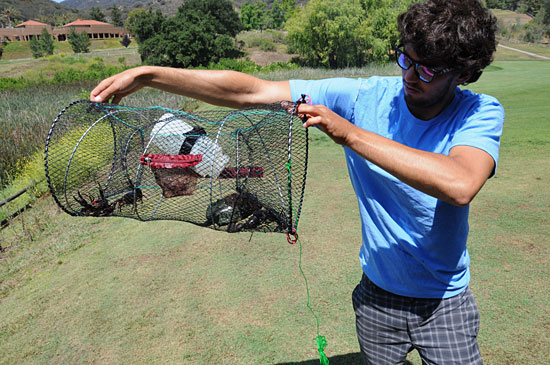
The proposed plan calls for the removal from streams of invasive species, such as non-native crayfish, seen here sharing a net with a Western pond turtle.
Posted 8/21/14
Our new social club—the L.A. River
August 13, 2014
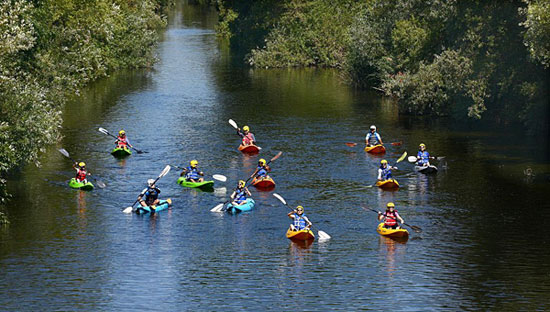
Once banned from most of the L.A. River, kayakers are now a regular summer sight. Photo/StreetsblogLA
Most Angelenos know that the Los Angeles River is making a comeback. Still, the hipsters hawking free breakfast on its banks were a surprise.
Waving their arms and proffering scrambled egg sandwiches and muffins they’d cooked on a camp stove, the group of about a dozen young people were on the bike path near Rattlesnake Park on Saturday morning, flagging down cyclists for no apparent reason beyond community building.
“They said they had done it before, and had just decided to do it again,” said one passing cyclist, a 24-year-old from Eagle Rock who’s been riding along the river near Griffith Park for years. “It seemed like they were just, like, ‘Let’s just get together and do something nice.’”
Gathering at the river to do something nice has become a trend this summer, as momentum has built around the restoration and revitalization of L.A.’s long-suffering namesake waterway.
With scores of projects already complete and a $1 billion Army Corps of Engineers plan expected to dramatically improve an 11-mile stretch between downtown and Griffith Park, a nascent but notable scene has taken hold along the once-maligned L.A. River, particularly where it has been spruced up with pocket parks, hiking trails and bikeways.
This summer, for instance, kayaking tours are being offered in public recreation areas in the Sepulveda Basin and in Elysian Valley; later this month, about 100 stand-up-paddlers and rowers will gather in the Glendale Narrows for a first-ever L.A. River Boat Race.
The Los Angeles River Corp. is offering outdoor bike-in movies along the riverbanks later this month and has its second annual Greenway 2020 10k race scheduled for early November. Meanwhile, the Elysian Valley Arts Collective will host its annual Frogtown Art Walk again next month by the river. Nearby, Elysian, an underground restaurant that materialized two years ago on the river near Atwater Village, will be up and running, legally and officially.
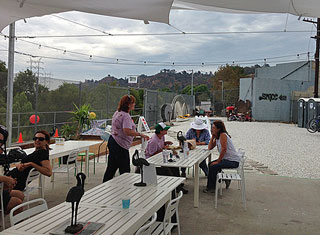
Along the L.A. River's concrete banks, The Frog spot offers food, concerts and more. Photo/Franklin Avenue Blog
Elysian is also the home of Clockshop, a non-profit arts and cultural organization, and the site for more than a few weddings during the past year. And speaking of art, be on the lookout for the L.A. Mud People, a performance art group that frequents the river both as a medium and a backdrop.
“It’s really kind of miraculous,” marveled Lewis MacAdams, president of Friends of the L.A. River, which has itself drawn thousands of passersby over the past six weeks by staging free weekend concerts at The Frog Spot, an informal venue it set up this summer on Benedict Street along the Elysian Valley bike path.
“We’ve been surprised at how many people have showed up—probably 500 or so every Saturday and Sunday,” said MacAdams, adding that FOLAR will also be sponsoring a catch-and-release fishing event next month. “People are getting interested, and looking for community.”
MacAdams sees the interest as an outgrowth of the long political fight to restore the river, which was paved in the 1930s in an attempt to tame periodic but lethal floods. Nearly 4,000 people participated this year in FOLAR’s long-running annual river cleanup, he said—a record turnout—and each cleanup has helped spread the news of the river’s revitalization and potential.
So far, MacAdams said, most of the community activities have centered around FOLAR and the Elysian Valley arts community near Frogtown. “But a lot of it also is the bicycle population,” he said. “There are more bicyclists than we imagined, and they keep coming back.”
Julia Meltzer, executive director of Clockshop and the wife of David Thorne, who runs Elysian restaurant, agreed that the riverfront has become exponentially more active.
“There’s a lot more recreation and sporting,” she said, acknowledging that the various improvements, from friendlier landscaping to paved bikeways, have created occasional conflicts among walkers, cyclists, locals and other constituencies.
Nonetheless, a first-ever, free community campout along the river that Meltzer said she helped organize over Memorial Day weekend—along with California State Parks, the Mountains Recreation and Conservation Authority, the Natural History Museum and others—was fully booked within an hour of its announcement.
“I think it’s the big buzz, and the opportunity to come down to the river’s edge legally now,” said MRCA Chief Ranger Fernando Gomez, adding that some 200 campers showed up on Memorial Day and that hundreds more have shown up this summer for MRCA river programs, ranging from free community paddles to evening weenie roasts in Marsh Park.
“It used to be that people weren’t allowed in the river without a special use permit—it wasn’t meant for recreation,” Gomez said. “People would look at the river and think it was disgusting.
“But now, they can go down in, say, a kayak, and they see that the water is actually pretty clean, and there’s a heron right over there taking off with a fish in its mouth. They see that it’s not just all about concrete anymore,” Gomez said. “It’s a river—a real live river—now and people want to be part of it.”
Posted 8/6/14
The path more travelled
July 24, 2014
People are increasingly hitting the dusty trails and wilderness areas of the Santa Monica Mountains these days.
During the first six months of this year, the National Parks Service recorded 547,243 visits to the area—146,700 more than in the same period last year, a whopping 37% increase.
George Watland, Angeles Chapter director of the Sierra Club, said that kind of attendance surge is great news for the environment.
“Having people visit protected areas makes them more aware of what they are and why they’re valuable,” Watland said. “We’re glad about that.”
The spike is part of a longer-term increase in park usage stretching back to 2007. Melanie Beck, the park’s outdoor recreation planner with the National Park Service, said that’s generally a positive thing.
“They’re seeing first-hand the beauty and peace that the park offers, as well as the health benefits,” Beck said. “We want that—it builds stewardship, not just for this park but for parks in general.”
While tourists and out-of-towners often prefer sites with a Hollywood past like Paramount Ranch, locals increasingly are taking advantage of places that they can reach during a day trip. Beck said the rise in park use closely coincided with the rise of social media. Specific locations now become popularized by photos and stories shared on Instagram, Facebook and Twitter, while websites like Meetup.com have created a spike in group hikes. Beck said 20 or more people will meet at a time, which can cause problems when inexperienced hikers venture off the beaten path onto rugged terrain.
“People tend to grab at branches and break them; they scrape lichens and other sensitive species off of rocks,” Beck said. “It’s better to stay on the designated trails when you’re going out with a group.”
While off-trail hiking is permitted by the National Park Service in the Santa Monica Mountains, large groups walking in a line can create impromptu new paths, damaging habitat in the process. Horseback riding, mountain biking and dog walking off-trail are strictly prohibited.
Another problem occurs when hikers put themselves at risk by taking on wilderness that is above their ability level. Inspired by online videos, thrill-seekers become stranded, get injured, and often require assistance from local rescue units. (Across town in the Angeles National Forest, a series of fatal accidents recently prompted officials to close a popular hiking trail to Eaton Canyon’s Upper Falls.)
Organizations like Leave No Trace offer guidelines on how to get outdoors in environmentally responsible and safe ways, and the National Park Service distributes pamphlets, but Beck said more aggressive tactics are needed.
“We’re going to have to find new ways to educate people,” she said. “Things have just changed with social media.”
Beck is not trying to discourage would-be adventurers; she wants as many people as possible to enjoy the land safely and responsibly. To that end, a member of her team organizes regular, free outdoor events that include wildlife-spotting expeditions, campfire talks and youth fitness outings. Many of the events have an educational angle and are led by experts who share their nature savvy.
The heaviest trail traffic comes on sunny days when schools are out of session, but Beck and veteran hikers prefer cool, overcast days, early mornings and late evenings, when fewer people are out and the weather is more comfortable. Beck took advantage of last weekend’s clouds to hike what is usually one of the park’s hottest trails, temperature-wise—the China Flats Trail in Cheeseboro Canyon. She even spotted a tarantula along the way (the spiders prefer cloudy weather, too).
One major advantage of public wilderness areas is that they offer solitude and a connection with nature, especially in the remote areas of park, which are particularly sensitive to foot traffic. That appeals to L.A.’s city-dwellers. “They’re going places in the mountains that we never expected people to go, and in numbers,” Beck said. “I hope they can use the park safely, without damaging resources. That takes an educated public and a caring public.”
Posted 7/24/14
Green river milestone
July 10, 2014
Improving the Los Angeles River has become a local cause célèbre, with increasing numbers of Angelenos pushing to transform the concrete channel into a place where people can exercise, play and relax.
This Saturday, L.A. County takes a big step toward that goal when it opens the L.A. River Headwaters Project, which is located at the river’s official beginning—the convergence of Calabasas and Bell creeks in Canoga Park.
The $11.5 million project is the river’s largest greenway improvement so far, with 2.5 miles of upgrades that benefit the public and the environment. Cung Nguyen, the river’s watershed manager for the Department of Public Works, said the opening is an important milestone.
“If we improve the beginning and end of the river, then we can start filling in all the gaps,” Nguyen said. “Ultimately, the grand picture is to provide connectivity for recreation along the whole river.”
Joggers and bicyclists will gain access to 2.5 miles of new trails (1¼-mile in each direction) on which to ride and run, passing safely under street crossings and over pedestrian bridges. Rest areas with benches will provide pit stops for those who prefer to take a slower pace.
Native landscaping replaces the former backdrop of an access road and chain link fencing. It also creates new habitat for wildlife, including 300 species of migratory birds that rest their wings by the river. Maintenance crews have been trained to know when nesting seasons are so they won’t disturb the avian guests as they pass through.
The project is still designed to help prevent devastating floods while reducing the amount of urban runoff with bioswales—subsurface plant and sediment-filled structures that let water seep into the ground to be filtered naturally rather than getting fast-tracked, pollutants and all, into the ocean. Nguyen estimated that up to 587,000 gallons of water will be recaptured in an average year.
The headwaters project is funded by the county Flood Control District, along with a $1.8 million grant from Prop. 84, a state initiative dedicated to improving water systems. The project originated with the 1996 L.A. River Master Plan, which recognized the waterway’s importance as a natural resource and targeted publicly-owned lands for future projects. More than 50 of those projects have been completed to date, with another 50 or so to come. Coming up are more greenways like the headwaters project as well as things like wetlands, parks, bike paths and kayaking programs. Just last month, another San Fernando Valley greenway, the half-mile Valleyheart Riverwalk project, opened between Studio City and Sherman Oaks.
While those project-by-project efforts continue, a $1 billion revitalization plan approved by the Army Corps of Engineers in May is expected to drastically improve a sweeping 11-mile section of the river between downtown L.A. and Elysian Park.
But every piece matters; even after the entire river is revitalized, few people will use all 51 miles of it in a single day. The local community of Canoga Park stands to benefit most from the headwaters project, something that Luis Rodriguez, principal of Canoga Park High School, is keenly aware of. His school sits just west of the headwaters. He sees a great educational opportunity for his students, who have been focusing on topics like water conservation and drought-resistant plants in the context of one of California’s most severe water shortages on record.
“For our school it makes a huge difference, but it’s going to revamp the entire community in a positive way,” Rodriguez said. “There’s so much industry in our area, but living spaces where people can have fun? That’s something that is really needed.”
The official opening ceremony takes place at 11 a.m. on Saturday, July 12, at DeSoto Avenue and the Los Angeles River in Canoga Park, 91303.
Posted 7/10/14
The L.A. River’s stormy past
June 5, 2014

After pounding storms in 1938 brought death and destruction, the river would be tamed with concrete.
For decades, the Los Angeles River has been ridiculed across the country as being as fake as a Botox brow, maligned in its own backyard as nothing more than a 51-mile concrete eyesore. But the river’s image is about to undergo a game-changing makeover, thanks to the Army Corps of Engineers’ recent endorsement of a $1 billion revitalization plan, which more than doubled an earlier recommendation.
The plan to transform an 11-mile stretch of the river from Griffith Park to downtown L.A. is intended to give people of all ages a healthy urban getaway, where they can relax and play. But back in the days when the river was first encased in concrete in one of the nation’s largest Depression-era public works projects, the federal government’s investment was about much more than improving lives. It was about saving them.
The unpredictable waterway had killed hundreds of people during a series of storms that had repeatedly devastated the region over the previous half-century. Two particularly vicious wallops in the 1930s forced local officials to seek federal help. The first, in 1934, killed dozens of people in a watery siege witnessed by folk songwriter and poet Woody Guthrie, who memorialized it in The Los Angeles New Year’s Flood:
Whilst we all celebrated
That happy New Year’s Eve,
We knew not in the morning
This whole wide world would grieve;
The waters filled our canyons
And down our mountains rolled;
That sad news rocked our nation
As of this flood it told.
No, you could not see it coming
Till through our town it rolled;
One hundred souls were taken
In that fatal New Year’s flood.
But it was the urgency generated by a second deadly storm, this one in 1938, which brought the biggest infusion of federal dollars through the New Deal’s Works Progress Administration to protect the safety of one of America’s fastest growing regions. Between February 27 and March 3 of that year, Los Angeles, Orange and Riverside counties were drenched by more than 10 inches of rain. The river jumped its banks and flooded a third of the city, killing 115 people, while destroying or damaging more than 6,000 homes. Total property damage was about $1.44 billion in today’s dollars. (See video footage of the flood here.)
The Los Angeles County Flood Control District, overseen by the Army Corps of Engineers, put 17,000 people to work on the job at the height of the Great Depression. Almost all of the work was done by hand. They moved 20 million cubic yards of earth, poured 2 million cubic yards of concrete, laid 150 million pounds of steel and set 460,000 tons of stone. The entire length of the L.A. River was channelized, along with 147 miles of tributary channeling. Also built were 5 flood control basins and 316 bridges.
The transformation of the river took 20 years to complete.
By the time it was finished, the L.A. River was unrecognizable from its natural state. About 90% of it had been lined with concrete along its sides and bottom. A natural riverbed was kept for the remaining 10%. Formerly a home for frogs, fish and birds, the river became a graffiti-scarred channel for urban runoff and garbage, sending pollutants of various sorts speeding towards the sea. It was immortalized in movies like Grease and mocked by comedian Conan O’Brien.
It was, in short, a river in name only—a reputation that restoration leaders are now determined to change, while maintaining the river’s ability to control flood waters.
In addition to the billion-dollar revitalization project, there are ongoing efforts to build a continuous 50-mile bike path and greenway along the river. Last summer, a pilot kayaking program was launched in the Elysian Park neighborhood. Based on its success, the L.A. City Council voted in February to make the program permanent, while expanding it to another section of the river, the Sepulveda Basin.
So for now, although the history of the L.A. River is still being written, a new chapter has opened.
Posted 6/5/14




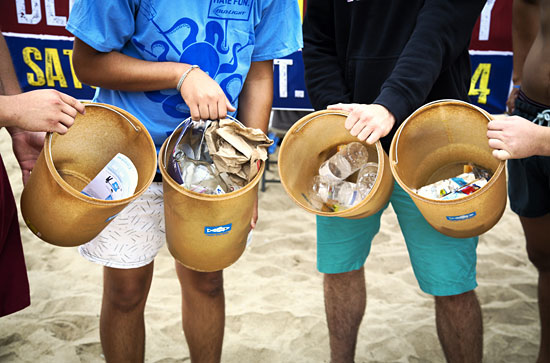
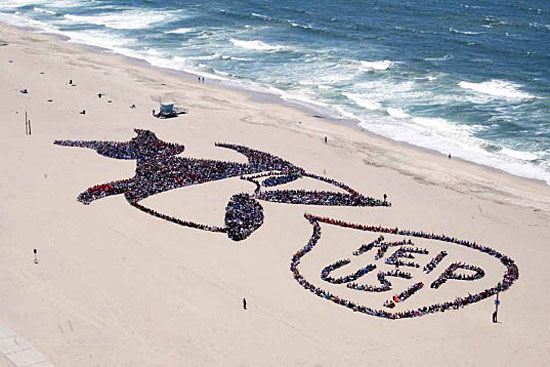
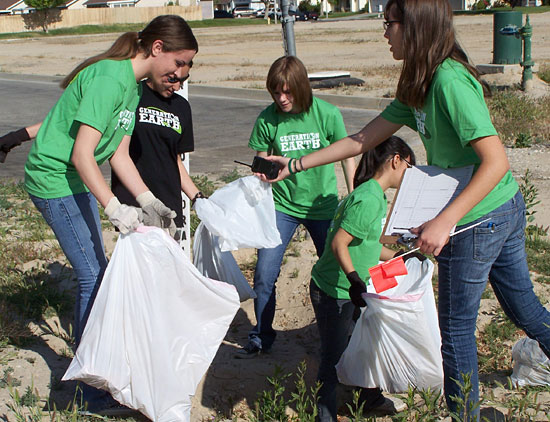

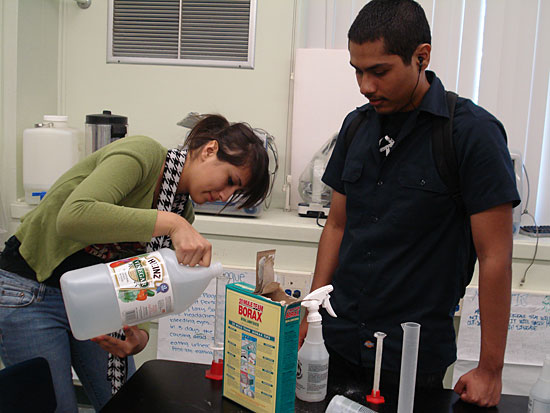
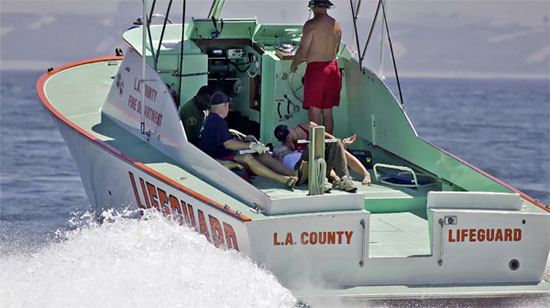
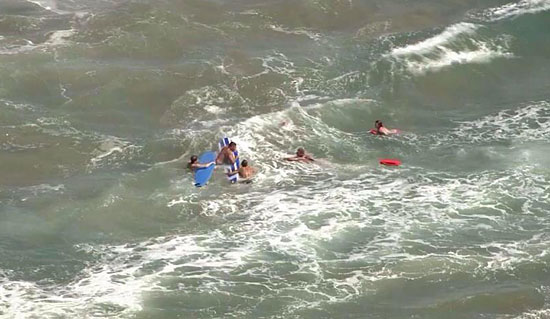
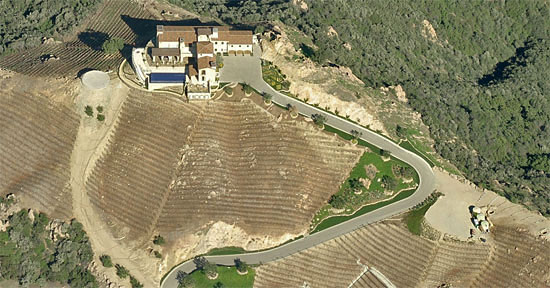
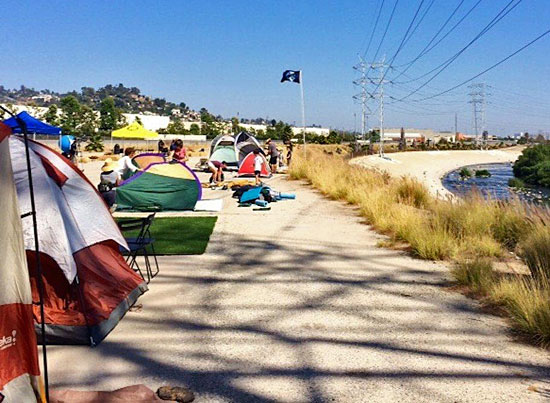

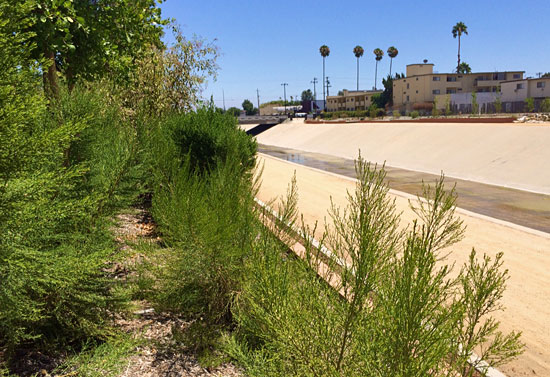
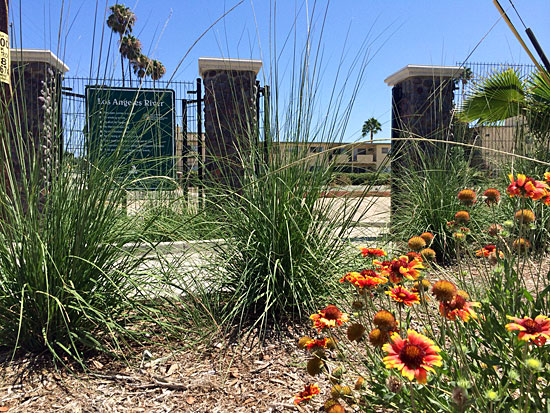
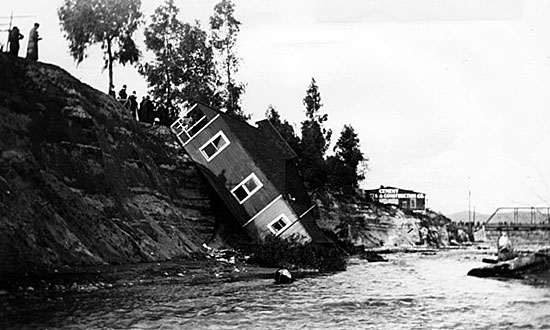
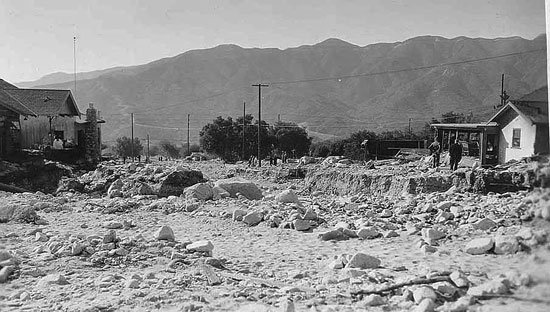
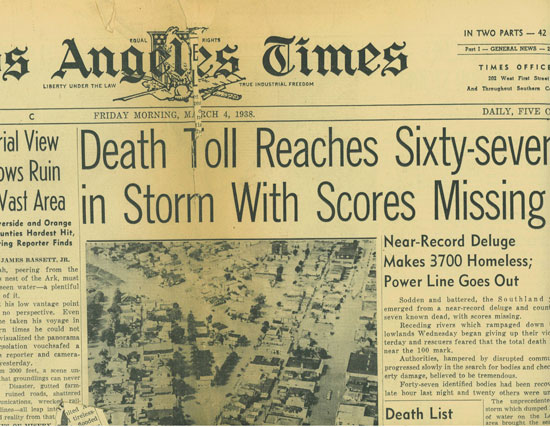
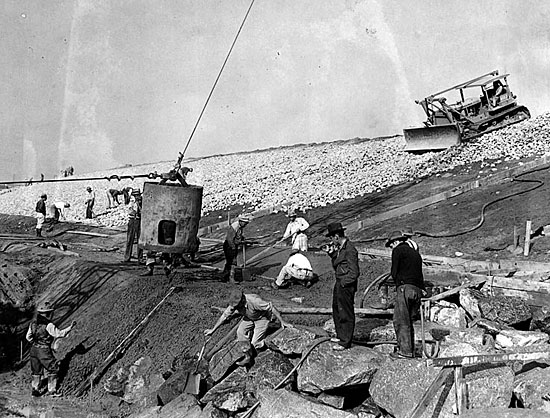
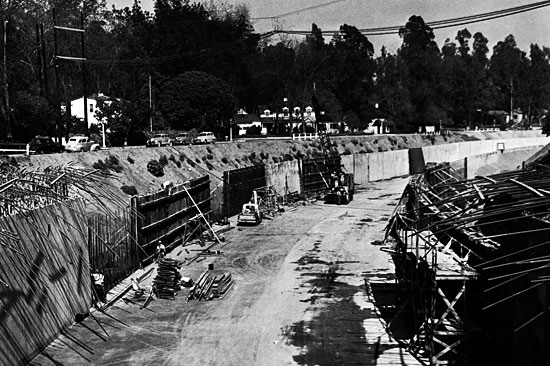
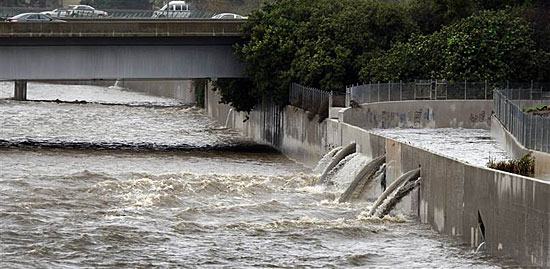
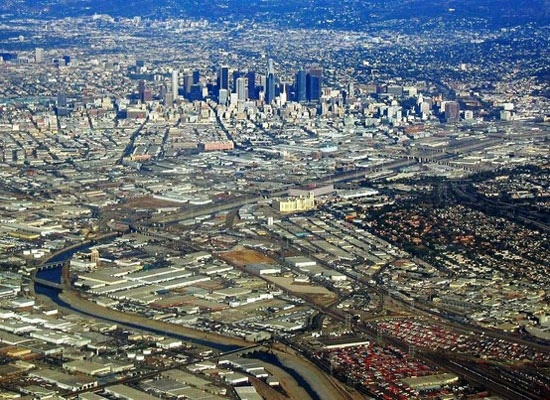
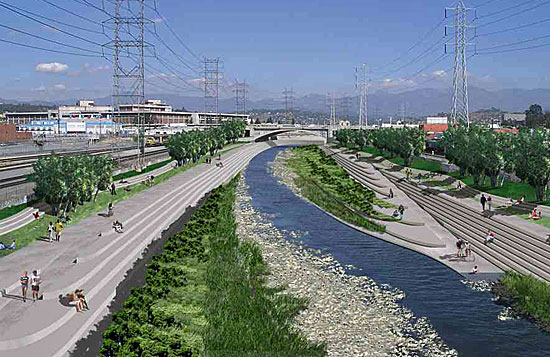







 405 bridge work causes a stink
405 bridge work causes a stink
